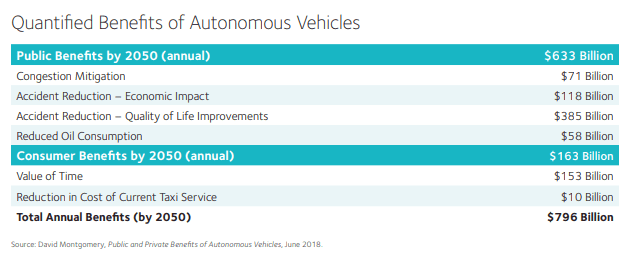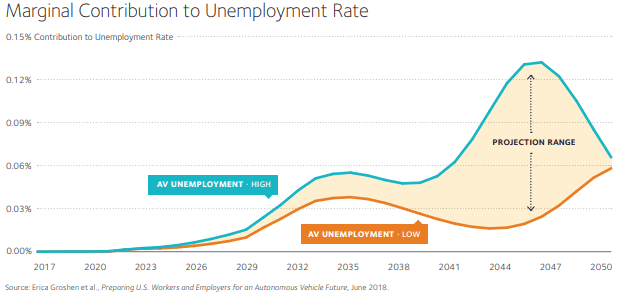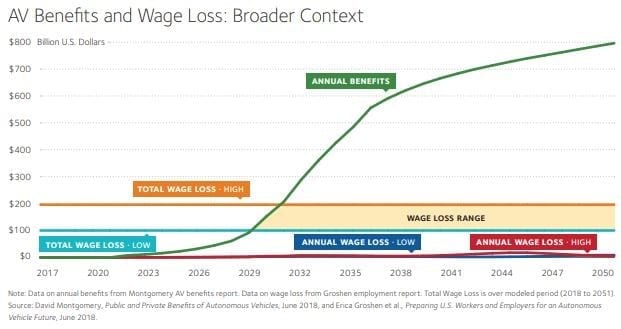As the development and adoption of autonomous vehicles (AVs) has moved from a concept to real-world testing, the need to develop policies surrounding this new technology has emerged as a central policy concern, both in the United States and across the world. The majority of the focus on autonomous vehicles has been on the tremendous social benefits this technology stands to bring, potentially on a scale unseen since the invention of the automobile itself.
Autonomous vehicles (AVs) have the potential to dramatically improve life for all Americans, as they move from concept to real-world testing.
From spurring significant reductions in vehicle accidents and roadway fatalities by taking drunk, tired or distracted drivers out of the equation to opening up mobility for millions of disabled, senior or wounded veterans, autonomous vehicles have the potential to dramatically improve life for all Americans. However, there have been some concerns raised over what the impacts will be on U.S. workers. The current literature on these impacts is limited, and the headlines that do emerge are largely from sensationalized scenarios of autonomous vehicles decimating the U.S. labor force.
It is these concerns that Securing America’s Future Energy (SAFE) addresses in its latest report, America’s Workforce and the Self-Driving Future: Realizing Productivity Gains and Spurring Economic Growth. SAFE, a nonprofit, nonpartisan group dedicated to reducing American dependence on oil, commissioned three reports from leading transport and labor economists, including former U.S. Bureau of Labor Statistics Commissioner Erica Groshen, former NERA Economic Consulting senior vice president W. David Montgomery and Richard Mudge, President and Founder of Compass Transportation and Technology. From the reports authored by these economists, SAFE created a policy brief that interpreted and extrapolated their findings within the context of contemporary policy discussions.
The latest report from SAFE addresses concerns raised over what impacts autonomous vehicles will have on U.S. workers, the report found the benefits will far outweigh job disruption.
The findings were clear: Although there will be some limited job disruption as autonomous vehicle adoption increases in the 2030s and 2040s, the benefits will far outweigh these impacts. As outlined in the table below, the total annual benefits of autonomous vehicles adoption could reach approximately $800 billion by 2050. These are made up of a combination of societal and economic benefits—the societal benefits principally include congestion mitigation, the financial impacts of accident reduction and reduced oil consumption either through efficiencies or increased adoption of electric powertrains. The consumer benefits come from recapturing time lost to driving for work, leisure activities or other pursuits instead of driving. As a result, the cumulative consumer and societal benefits to the U.S. economy will be between $3 and $6 trillion dollars by 2050.
The benefits have the potential to be felt far beyond individual road users. Given that autonomous vehicles stand to reduce the time and cost of travel, there are significant expected benefits both for the retail sector and employers as a whole. Reduced cost of travel time has the potential to revitalize retail: Malls will have greater customer bases, and the cost of visiting a mall will decrease for would-be shoppers. Additionally, these lower travel costs will likely lead to better access to jobs for broad swaths of the population, allowing workers to travel further for a better-paying or preferred job. AVs can also grow the number of job-seekers for employers to draw upon, making it easier to expanding the pool of potential employees.
Autonomous Vehicles will have Limited Negative Impact on the Labor Market
The report found that the impacts on the U.S. workforce would be moderate. In the most pessimistic scenario, the economists see that job disruption would only become noticeable in 2030s and AVs may add only 0.06-0.13 percentage points to unemployment in the 2040s—the peak years for job disruption, according to the findings. In comparison, the Great Recession added 4.9 percentage points to the unemployment rate at its 2010 peak.
From now through 2050, approximately 1.1-2.4 million jobs, as high as only 1.5 percent of the overall workforce, will be affected by AVs. To put this number into context, almost 8 million people last year were employed by companies that will grow with the adoption of AVs. A return to full employment is then predicted in the 2050s, as AVs create new jobs that will, over time, replace those lost to automation. Although the range of projected wages lost reaches as high as $18 billion in 2044 and 2045, it is essential to note that this goes hand-in-hand with projected social benefits well in excess of $700 billion for each of those years. In fact, not only are the social and economic benefits of AVs significantly more than their costs to workers on an annual basis, but the benefits of AVs each year are far greater than the total cost to workers over the next 35 years combined, as shown in the graph below.
Yet, for these changes in the workforce to occur with minimum disruption, it is important that policies are put in place as soon as possible, even if the effects will not be felt until the 2030s. By pursuing a rapid deployment of autonomous vehicles, combined with investments in workforce policies that seek to mitigate costs to workers, along with policies that address other risks or costs that might emerge alongside greater autonomous vehicle adoption, the U.S. can see the full benefits of autonomous vehicles relatively soon while simultaneously preparing the workforce for the jobs of the future. The policies must be broad-based, comprehensive enough to cope with differing demands in communities nationwide, and backed by greater amounts of data and research than are currently being carried out in research regarding AVs. Starting now gives policymakers significant lead time to research, design, and implement workforce development solutions. Stakeholders, and society as a whole, do not have to choose between the compelling benefits of AVs and the stable evolution of the workforce.
To learn more about the policy brief, the economists’ report that informed this piece, visit the report homepage for copies of the studies, top-line summaries and an archived live stream of SAFE’s launch event.






